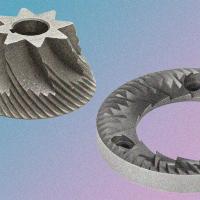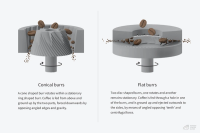Conical burrs vs. flat burrs
Understanding the fundamental differences between the two types, and how they impact your coffee.

Table of contents
How do they work?
Burr grinders work by forcing coffee beans between two grooved and serrated surfaces called burrs. They come in two shapes: flat and conical. Unlike blade grinders, burrs produce a more consistent particle distribution over a wider range of grind sizes.
There are a few big differences between flat burrs and conical burrs (and lots of small ones), but you can make delicious coffee with both. But since coffee grinders are a big purchase, it’s worth considering the details.
Conical burrs
A cone shaped burr rotates within a stationary ring shaped burr. Coffee is fed from above and ground up by the two parts, forced downwards by opposing angled edges and gravity.
Flat (disc) burrs
Two disc shaped burrs, one rotates and another remains stationary. Coffee is fed through a hole in one of the burrs, and is ground up and ejected outwards to the sides, by means of angled opposing "teeth" and centrifugal force.

Coffee is broken down into smaller and smaller particles as it travels outward, until they’re small enough to escape through the gap between the outer edges of the burrs.
Adjusting this 'gap' between the burrs changes the resulting grind size. A smaller gap makes finer grounds and a larger gap makes coarser grounds.
The differences between conical burr grinders and flat burr grinders
Power and mechanism
The fundamental difference between the two types of burrs (other than their shape), is their source of power. Although a conical burr grinder can either be manually or electrically powered, commercial flat burrs are always electrically powered. This is because they require much more power than what can be provided by hand.
There are two major reasons why flat burrs require more power:
- Flat burrs have much shallower 'teeth' compared the larger 'pre-breakers' that conical burrs have. This means the rate at which flat burrs can crush beans is not only slower than conical burrs, the rate at which beans can be fed into the burrs decreases as well. Flat burrs don't have the prominent geometry of conical burrs, so they compensate by rotating faster. Like using different grades of sandpaper, you would need to sand much faster and stronger with a fine grit to remove the same amount of wood that a rougher grit sandpaper can do in the same amount of time.
Not only do flat burrs have fewer larger teeth, they have less surface area than conical burrs of similar size. Coffee that travels through a conical burr will be ground down over more surface than in a flat burr, requiring less power and time to do the same amount of work.

- Flat burrs need more energy to force the coffee out of itself. Both types of burr require different forces to drive the coffee through the burrs. Burrs can catch coffee beans and force them through with their angled teeth, but this isn't enough.
The way conical burrs are shaped and oriented, means that they have the advantage of gravity naturally pulling the beans down into the teeth. That is why conical burrs are always vertically aligned, with the exit gap/aperture facing downwards.
Flat burrs on the other hand, have to push coffee to the sides. This means they have to rely on inertia/centrifugal force created by the rotating burrs to force the beans outwards.
The same type of force that you feel when on a round merry-go-round or in car that is suddenly turning. To create a strong enough centrifugal force to grind through enough beans in a short amount of time, flat burrs have to spin very fast. Faster than electrical conical burr grinders on average, and far quicker than what a person can do with a hand grinder.
Noise
There's a lot of information online stating that flat burr grinders cause more noise than conical burr grinders. The justification given, always points to the higher RPM required to operate flat burrs but this is a bit misleading. It is true that on average, flat burr grinders will have louder motors, but the noise the machine emits really depends on other factors.
Most coffee grinders are loud, and it doesn't matter if they're conical or flat. The loudness depends on the overall quality of the grinder, and how much the designers and manufacturers have prioritised the sound proofing of the grinder.
If noise level is a deciding factor in your brewing process, many coffee grinder providers define noise emissions in their specifications. But don't let the type of burr affect your decision.
Heat
The more coffee is ground by the burrs the more friction it creates. This increases the temperature of the burrs, and even the coffee beans themselves. These temperature surges can have negative side effects on the taste of the final cup.
Flat burrs have to spin faster, which makes them heat up quicker. Their smaller surface area compared to conical burrs means they have more contact with coffee beans too, increasing friction and therefore more heat.
Temperature isn’t a problem if you only make a few coffees at home, but in a busy cafe where you run the grinder all day, excess heat could become an issue.
Coffee ground retention
Due to their shape, flat burrs retain more coffee after grinding than conical burrs, increasing the chance of contaminating a future grind. It's for this reason that in many flat burr grinders the burrs are tilted or even vertically aligned, so that as much coffee can naturally fall out.

This is not a major issue if you grind a lot of coffee everyday, as you are pushing out the older grounds constantly. But this is more of a problem if you only make a coffee a day, as stale coffee retained over night can really affect your next brew.
If accessing your burrs isn't a hassle, make sure to clean them out before grinding again, especially if it's been more than a few hours since you've used them.
Cleaning
Cleaning your burrs is very important as mentioned before, especially with flat burrs. Generally speaking, flat burrs are harder to clean than conical burrs, but many models allow you to access them more easily.
Some accessories like bellows/air blowers can help clean out the grinder chamber without having to open up the machine.
Cost
Flat burr grinders on average are more expensive than conical burr grinders. Not only because they are more expensive to manufacture (due to more powerful motors and machining of the burrs), but also because there is less demand for them compared to conical burrs.
But this is just an average. There are many affordable options for flat burr grinders that compete with conical burr counterparts.
Particle size distribution and taste
There is a consensus that flat burr grinders create a more uniform/unimodal grind size, and that conical burrs create a bimodal grind size. Of course in reality, this rule doesn't always fit, as there are many conical burr grinders than can create a more unimodal grind size than some flat burrs, and vice versa.
Although this statement might be a generalisation, it's a good way to compare the grind size capability of a flat and conical burr grinder in the same price range, but we are talking about very fine margins.
Flat burrs generally produce less fines than conical burrs. Less fines will reduce body and increase clarity, which is often why flat burrs are favoured for brewing methods that require a coarser grind, like French press or filter coffee.
Conical burrs generally produce more fines. Which creates drinks with more body and texture. This can be especially desired for brewing methods with finer grind requirements, like espresso or moka pots.
To reiterate, either type of burr can be used for any brewing method, but with different positive results. Neither type is objectively better than the other, so ultimately the decision falls on your tastes and choice of brewing method.
Which one should I choose?
When selecting a grinder, always consider factors beyond just burr shape, such as the reputation of the brand, customer reviews, and the grinder's ability to deliver a consistent grind. But conical burrs and flat burrs do have different perceivable influences on the final cup.
So if you prefer a stronger body and texture to your coffee, lean towards getting a conical burr grinder. If you prefer a cup with more clarity and less body, we recommend getting a flat burr grinder.